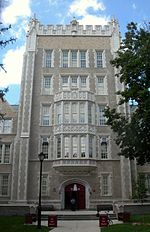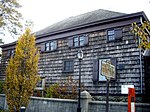Lewis H. Latimer House

The Lewis H. Latimer House, also called the Latimer House or the Lewis Latimer House, is a historic house located at 34-41 137th Street in Flushing, Queens, New York City. It was constructed in the Queen Anne style of architecture between 1887 and 1889 by the Sexton family. It served as the home of the African-American inventor Lewis Howard Latimer from 1903 to 1928, and is now operated as a museum dedicated to the inventor's work. In addition, this museum-house also illuminated the life and achievements of other black scientists. The house remained property of the Latimer family until 1963. Currently, the Lewis H. Latimer House is owned by the New York City Department of Parks and Recreation, operated by the Lewis H. Latimer Fund, Inc., and is a member of the Historic House Trust.
Excerpt from the Wikipedia article Lewis H. Latimer House (License: CC BY-SA 3.0, Authors, Images).Lewis H. Latimer House
137th Street, New York Queens County
Geographical coordinates (GPS) Address Phone number Website External links Nearby Places Show on map
Geographical coordinates (GPS)
| Latitude | Longitude |
|---|---|
| N 40.766063 ° | E -73.829402 ° |
Address
Lewis Howard Latimer House Museum
137th Street 34-41
11354 New York, Queens County
New York, United States
Open on Google Maps










